Construction Law 218.763: Analyzing Ethics & Development in NZIQS
VerifiedAdded on 2023/06/14
|11
|2889
|201
Report
AI Summary
This report delves into the distinctions between profession and occupation within the construction industry, specifically examining the roles of architects, engineers, quantity surveyors, construction project managers, and contractors. It further analyzes the New Zealand Institute of Quantity Surveyor...
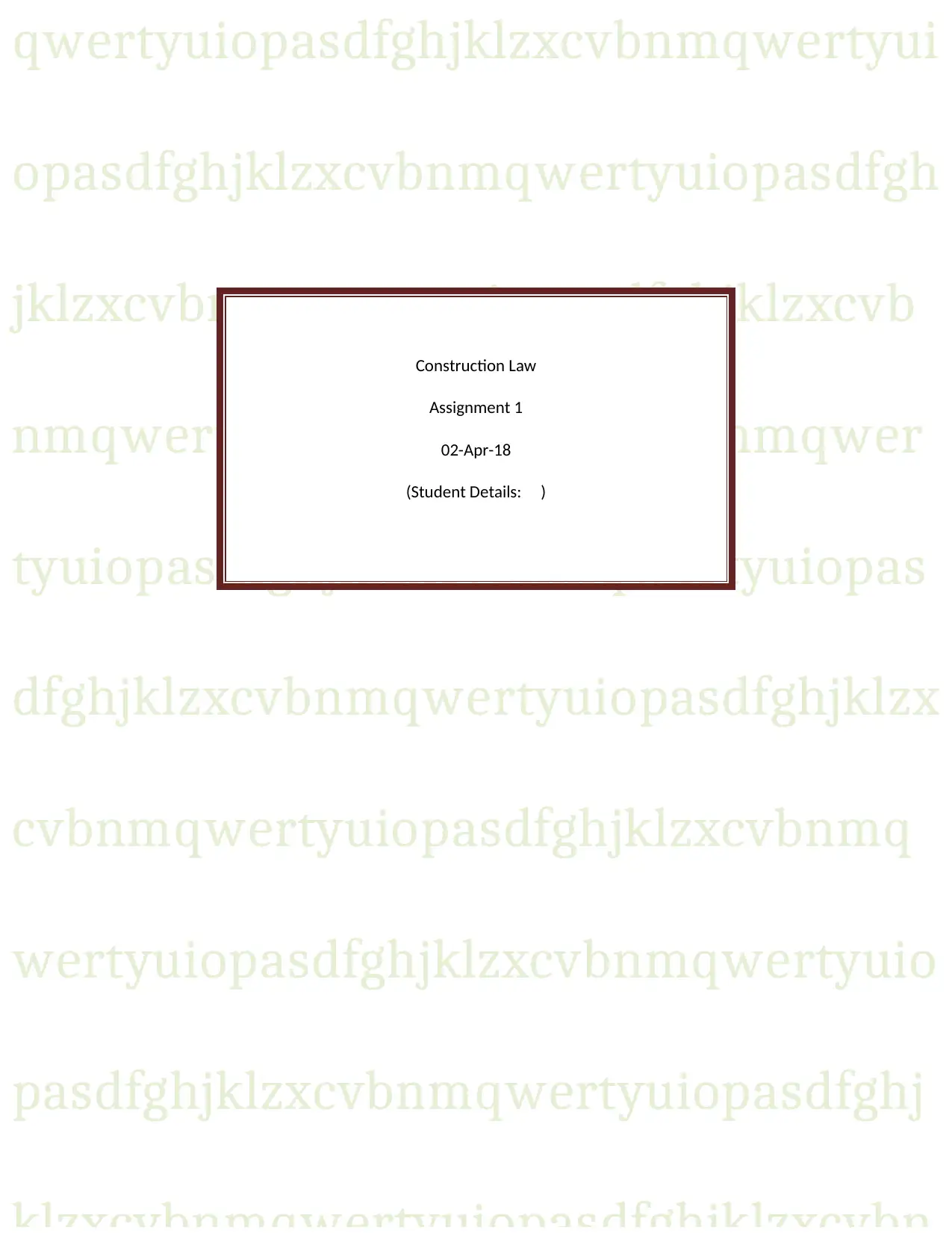
qwertyuiopasdfghjklzxcvbnmqwertyui
opasdfghjklzxcvbnmqwertyuiopasdfgh
jklzxcvbnmqwertyuiopasdfghjklzxcvb
nmqwertyuiopasdfghjklzxcvbnmqwer
tyuiopasdfghjklzxcvbnmqwertyuiopas
dfghjklzxcvbnmqwertyuiopasdfghjklzx
cvbnmqwertyuiopasdfghjklzxcvbnmq
wertyuiopasdfghjklzxcvbnmqwertyuio
pasdfghjklzxcvbnmqwertyuiopasdfghj
Construction Law
Assignment 1
02-Apr-18
(Student Details: )
opasdfghjklzxcvbnmqwertyuiopasdfgh
jklzxcvbnmqwertyuiopasdfghjklzxcvb
nmqwertyuiopasdfghjklzxcvbnmqwer
tyuiopasdfghjklzxcvbnmqwertyuiopas
dfghjklzxcvbnmqwertyuiopasdfghjklzx
cvbnmqwertyuiopasdfghjklzxcvbnmq
wertyuiopasdfghjklzxcvbnmqwertyuio
pasdfghjklzxcvbnmqwertyuiopasdfghj
Construction Law
Assignment 1
02-Apr-18
(Student Details: )
Secure Best Marks with AI Grader
Need help grading? Try our AI Grader for instant feedback on your assignments.
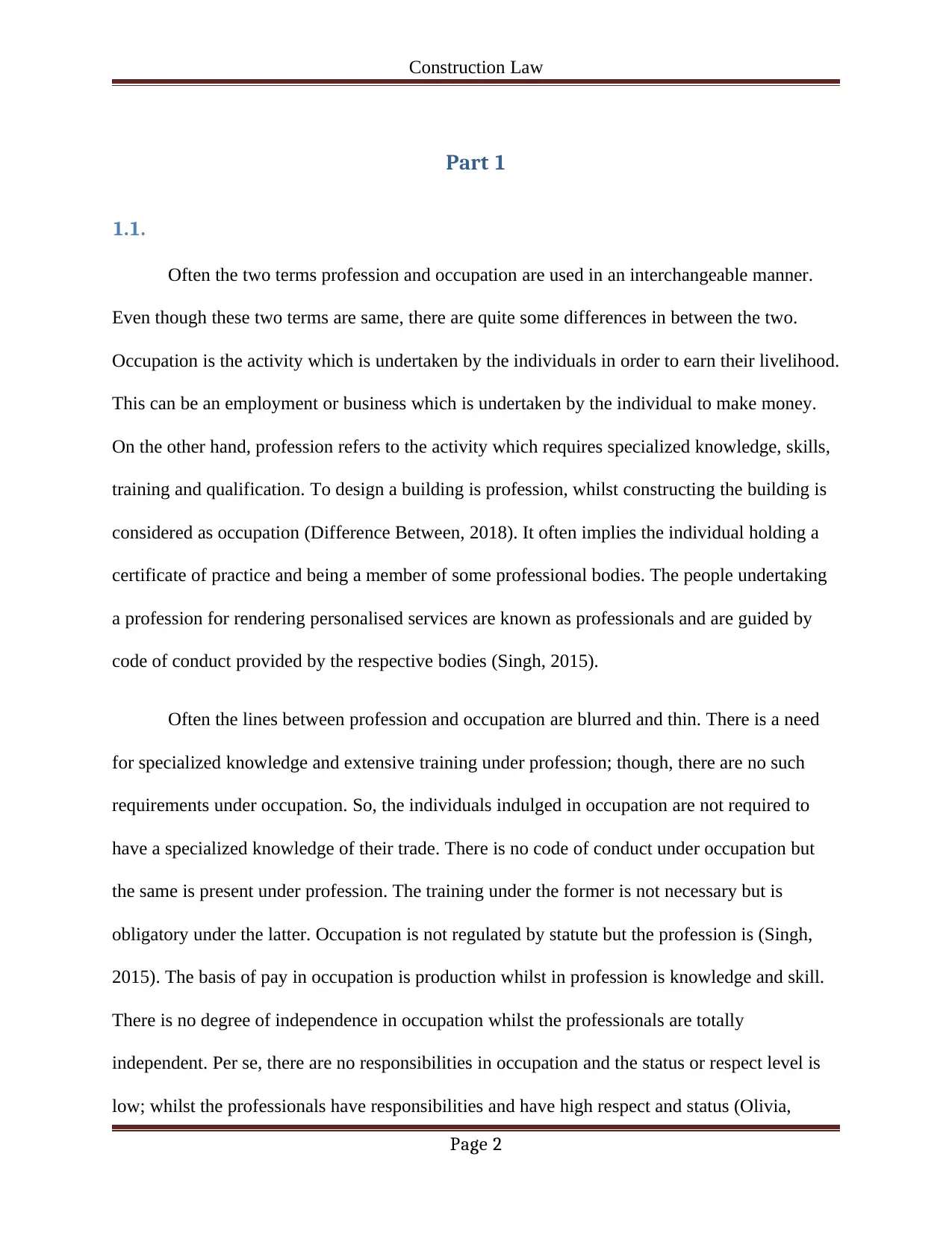
Construction Law
Part 1
1.1.
Often the two terms profession and occupation are used in an interchangeable manner.
Even though these two terms are same, there are quite some differences in between the two.
Occupation is the activity which is undertaken by the individuals in order to earn their livelihood.
This can be an employment or business which is undertaken by the individual to make money.
On the other hand, profession refers to the activity which requires specialized knowledge, skills,
training and qualification. To design a building is profession, whilst constructing the building is
considered as occupation (Difference Between, 2018). It often implies the individual holding a
certificate of practice and being a member of some professional bodies. The people undertaking
a profession for rendering personalised services are known as professionals and are guided by
code of conduct provided by the respective bodies (Singh, 2015).
Often the lines between profession and occupation are blurred and thin. There is a need
for specialized knowledge and extensive training under profession; though, there are no such
requirements under occupation. So, the individuals indulged in occupation are not required to
have a specialized knowledge of their trade. There is no code of conduct under occupation but
the same is present under profession. The training under the former is not necessary but is
obligatory under the latter. Occupation is not regulated by statute but the profession is (Singh,
2015). The basis of pay in occupation is production whilst in profession is knowledge and skill.
There is no degree of independence in occupation whilst the professionals are totally
independent. Per se, there are no responsibilities in occupation and the status or respect level is
low; whilst the professionals have responsibilities and have high respect and status (Olivia,
Page 2
Part 1
1.1.
Often the two terms profession and occupation are used in an interchangeable manner.
Even though these two terms are same, there are quite some differences in between the two.
Occupation is the activity which is undertaken by the individuals in order to earn their livelihood.
This can be an employment or business which is undertaken by the individual to make money.
On the other hand, profession refers to the activity which requires specialized knowledge, skills,
training and qualification. To design a building is profession, whilst constructing the building is
considered as occupation (Difference Between, 2018). It often implies the individual holding a
certificate of practice and being a member of some professional bodies. The people undertaking
a profession for rendering personalised services are known as professionals and are guided by
code of conduct provided by the respective bodies (Singh, 2015).
Often the lines between profession and occupation are blurred and thin. There is a need
for specialized knowledge and extensive training under profession; though, there are no such
requirements under occupation. So, the individuals indulged in occupation are not required to
have a specialized knowledge of their trade. There is no code of conduct under occupation but
the same is present under profession. The training under the former is not necessary but is
obligatory under the latter. Occupation is not regulated by statute but the profession is (Singh,
2015). The basis of pay in occupation is production whilst in profession is knowledge and skill.
There is no degree of independence in occupation whilst the professionals are totally
independent. Per se, there are no responsibilities in occupation and the status or respect level is
low; whilst the professionals have responsibilities and have high respect and status (Olivia,
Page 2
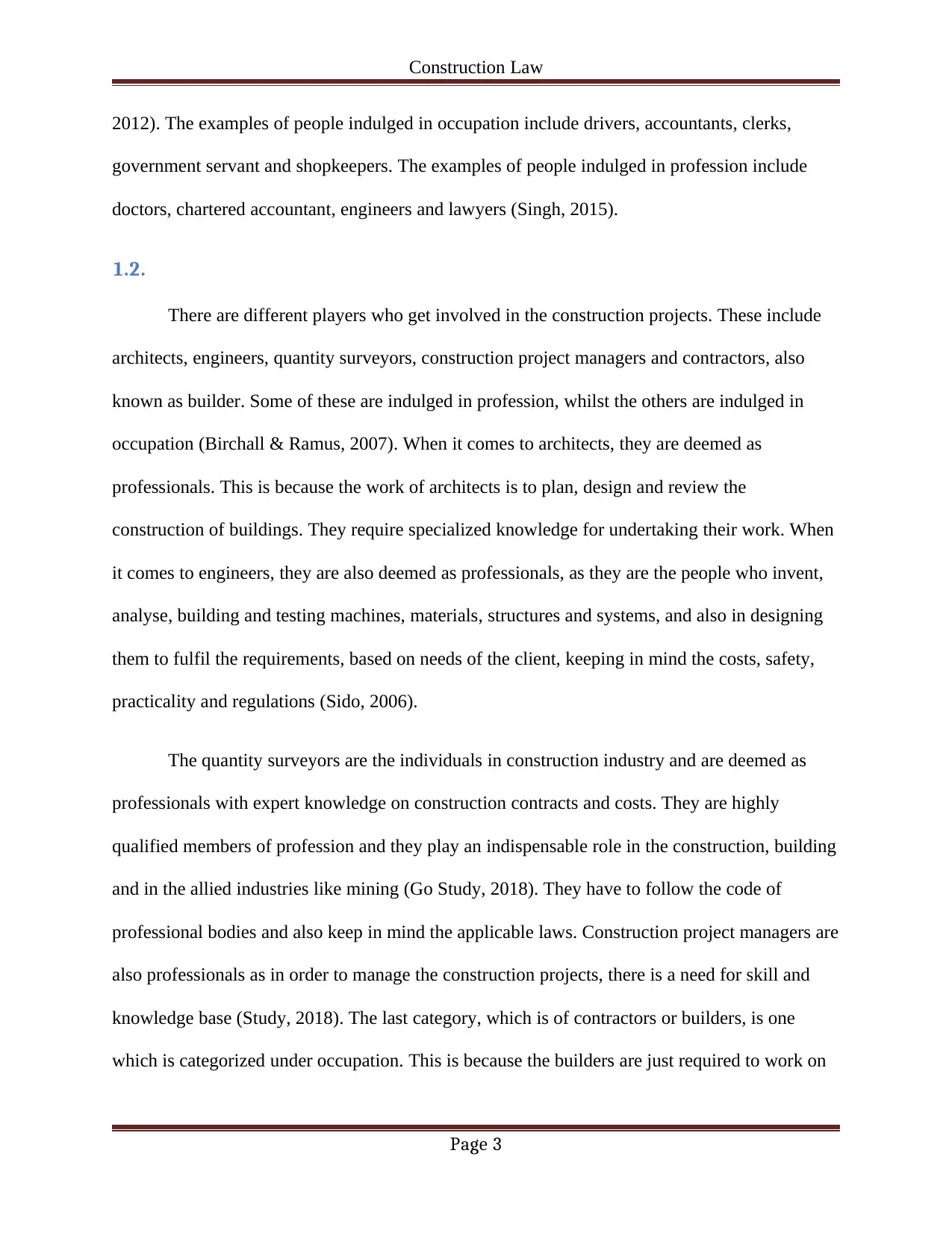
Construction Law
2012). The examples of people indulged in occupation include drivers, accountants, clerks,
government servant and shopkeepers. The examples of people indulged in profession include
doctors, chartered accountant, engineers and lawyers (Singh, 2015).
1.2.
There are different players who get involved in the construction projects. These include
architects, engineers, quantity surveyors, construction project managers and contractors, also
known as builder. Some of these are indulged in profession, whilst the others are indulged in
occupation (Birchall & Ramus, 2007). When it comes to architects, they are deemed as
professionals. This is because the work of architects is to plan, design and review the
construction of buildings. They require specialized knowledge for undertaking their work. When
it comes to engineers, they are also deemed as professionals, as they are the people who invent,
analyse, building and testing machines, materials, structures and systems, and also in designing
them to fulfil the requirements, based on needs of the client, keeping in mind the costs, safety,
practicality and regulations (Sido, 2006).
The quantity surveyors are the individuals in construction industry and are deemed as
professionals with expert knowledge on construction contracts and costs. They are highly
qualified members of profession and they play an indispensable role in the construction, building
and in the allied industries like mining (Go Study, 2018). They have to follow the code of
professional bodies and also keep in mind the applicable laws. Construction project managers are
also professionals as in order to manage the construction projects, there is a need for skill and
knowledge base (Study, 2018). The last category, which is of contractors or builders, is one
which is categorized under occupation. This is because the builders are just required to work on
Page 3
2012). The examples of people indulged in occupation include drivers, accountants, clerks,
government servant and shopkeepers. The examples of people indulged in profession include
doctors, chartered accountant, engineers and lawyers (Singh, 2015).
1.2.
There are different players who get involved in the construction projects. These include
architects, engineers, quantity surveyors, construction project managers and contractors, also
known as builder. Some of these are indulged in profession, whilst the others are indulged in
occupation (Birchall & Ramus, 2007). When it comes to architects, they are deemed as
professionals. This is because the work of architects is to plan, design and review the
construction of buildings. They require specialized knowledge for undertaking their work. When
it comes to engineers, they are also deemed as professionals, as they are the people who invent,
analyse, building and testing machines, materials, structures and systems, and also in designing
them to fulfil the requirements, based on needs of the client, keeping in mind the costs, safety,
practicality and regulations (Sido, 2006).
The quantity surveyors are the individuals in construction industry and are deemed as
professionals with expert knowledge on construction contracts and costs. They are highly
qualified members of profession and they play an indispensable role in the construction, building
and in the allied industries like mining (Go Study, 2018). They have to follow the code of
professional bodies and also keep in mind the applicable laws. Construction project managers are
also professionals as in order to manage the construction projects, there is a need for skill and
knowledge base (Study, 2018). The last category, which is of contractors or builders, is one
which is categorized under occupation. This is because the builders are just required to work on
Page 3
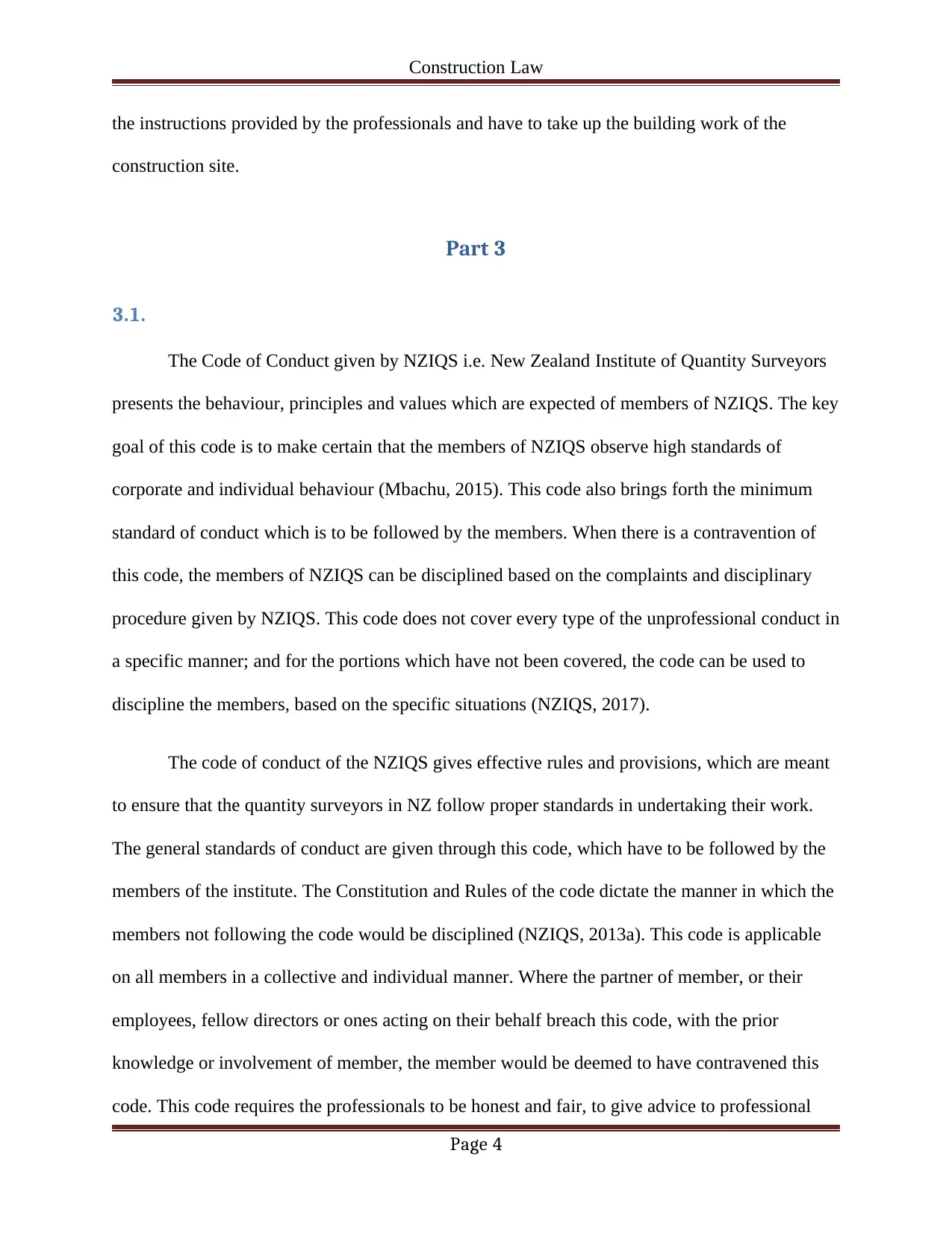
Construction Law
the instructions provided by the professionals and have to take up the building work of the
construction site.
Part 3
3.1.
The Code of Conduct given by NZIQS i.e. New Zealand Institute of Quantity Surveyors
presents the behaviour, principles and values which are expected of members of NZIQS. The key
goal of this code is to make certain that the members of NZIQS observe high standards of
corporate and individual behaviour (Mbachu, 2015). This code also brings forth the minimum
standard of conduct which is to be followed by the members. When there is a contravention of
this code, the members of NZIQS can be disciplined based on the complaints and disciplinary
procedure given by NZIQS. This code does not cover every type of the unprofessional conduct in
a specific manner; and for the portions which have not been covered, the code can be used to
discipline the members, based on the specific situations (NZIQS, 2017).
The code of conduct of the NZIQS gives effective rules and provisions, which are meant
to ensure that the quantity surveyors in NZ follow proper standards in undertaking their work.
The general standards of conduct are given through this code, which have to be followed by the
members of the institute. The Constitution and Rules of the code dictate the manner in which the
members not following the code would be disciplined (NZIQS, 2013a). This code is applicable
on all members in a collective and individual manner. Where the partner of member, or their
employees, fellow directors or ones acting on their behalf breach this code, with the prior
knowledge or involvement of member, the member would be deemed to have contravened this
code. This code requires the professionals to be honest and fair, to give advice to professional
Page 4
the instructions provided by the professionals and have to take up the building work of the
construction site.
Part 3
3.1.
The Code of Conduct given by NZIQS i.e. New Zealand Institute of Quantity Surveyors
presents the behaviour, principles and values which are expected of members of NZIQS. The key
goal of this code is to make certain that the members of NZIQS observe high standards of
corporate and individual behaviour (Mbachu, 2015). This code also brings forth the minimum
standard of conduct which is to be followed by the members. When there is a contravention of
this code, the members of NZIQS can be disciplined based on the complaints and disciplinary
procedure given by NZIQS. This code does not cover every type of the unprofessional conduct in
a specific manner; and for the portions which have not been covered, the code can be used to
discipline the members, based on the specific situations (NZIQS, 2017).
The code of conduct of the NZIQS gives effective rules and provisions, which are meant
to ensure that the quantity surveyors in NZ follow proper standards in undertaking their work.
The general standards of conduct are given through this code, which have to be followed by the
members of the institute. The Constitution and Rules of the code dictate the manner in which the
members not following the code would be disciplined (NZIQS, 2013a). This code is applicable
on all members in a collective and individual manner. Where the partner of member, or their
employees, fellow directors or ones acting on their behalf breach this code, with the prior
knowledge or involvement of member, the member would be deemed to have contravened this
code. This code requires the professionals to be honest and fair, to give advice to professional
Page 4
Secure Best Marks with AI Grader
Need help grading? Try our AI Grader for instant feedback on your assignments.
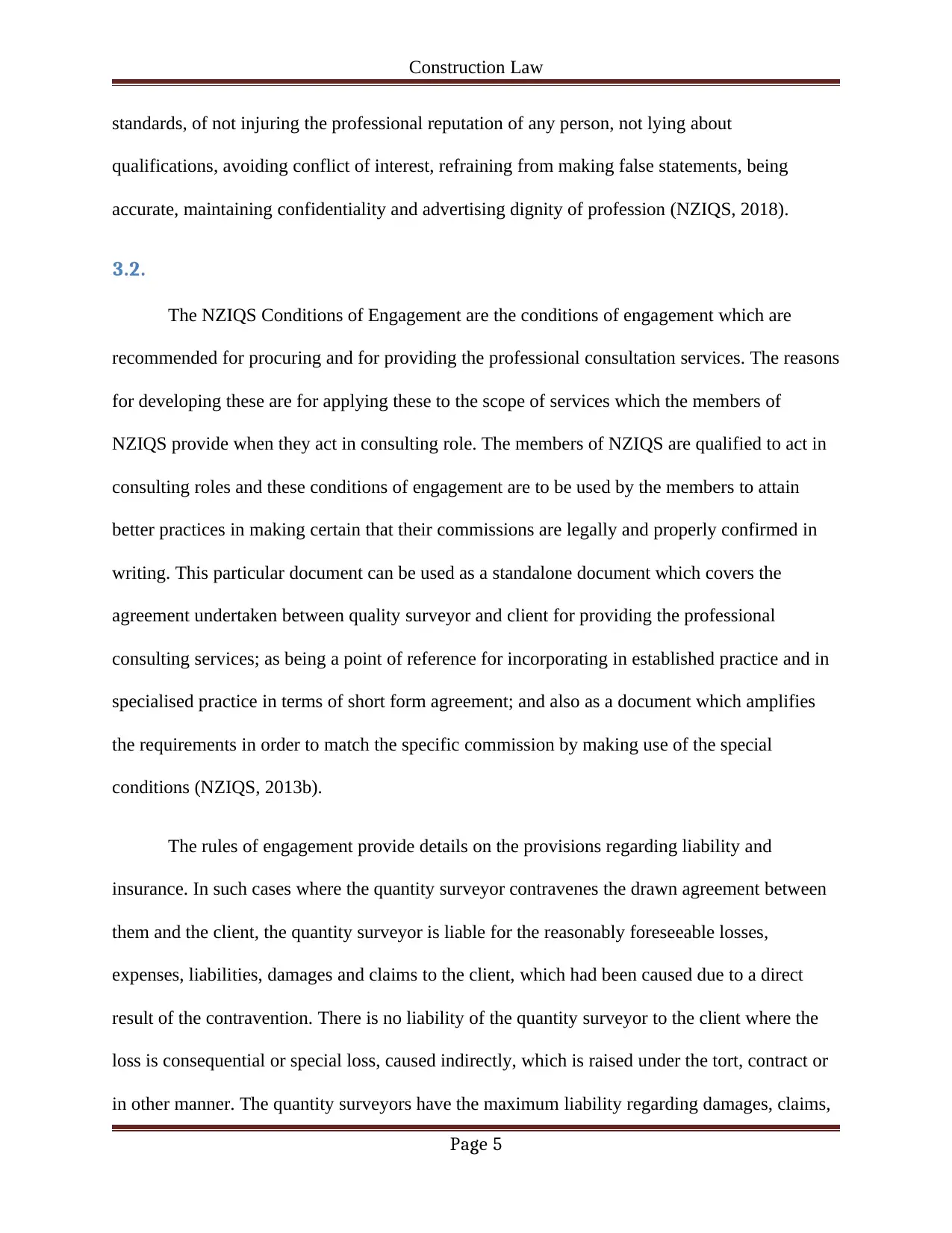
Construction Law
standards, of not injuring the professional reputation of any person, not lying about
qualifications, avoiding conflict of interest, refraining from making false statements, being
accurate, maintaining confidentiality and advertising dignity of profession (NZIQS, 2018).
3.2.
The NZIQS Conditions of Engagement are the conditions of engagement which are
recommended for procuring and for providing the professional consultation services. The reasons
for developing these are for applying these to the scope of services which the members of
NZIQS provide when they act in consulting role. The members of NZIQS are qualified to act in
consulting roles and these conditions of engagement are to be used by the members to attain
better practices in making certain that their commissions are legally and properly confirmed in
writing. This particular document can be used as a standalone document which covers the
agreement undertaken between quality surveyor and client for providing the professional
consulting services; as being a point of reference for incorporating in established practice and in
specialised practice in terms of short form agreement; and also as a document which amplifies
the requirements in order to match the specific commission by making use of the special
conditions (NZIQS, 2013b).
The rules of engagement provide details on the provisions regarding liability and
insurance. In such cases where the quantity surveyor contravenes the drawn agreement between
them and the client, the quantity surveyor is liable for the reasonably foreseeable losses,
expenses, liabilities, damages and claims to the client, which had been caused due to a direct
result of the contravention. There is no liability of the quantity surveyor to the client where the
loss is consequential or special loss, caused indirectly, which is raised under the tort, contract or
in other manner. The quantity surveyors have the maximum liability regarding damages, claims,
Page 5
standards, of not injuring the professional reputation of any person, not lying about
qualifications, avoiding conflict of interest, refraining from making false statements, being
accurate, maintaining confidentiality and advertising dignity of profession (NZIQS, 2018).
3.2.
The NZIQS Conditions of Engagement are the conditions of engagement which are
recommended for procuring and for providing the professional consultation services. The reasons
for developing these are for applying these to the scope of services which the members of
NZIQS provide when they act in consulting role. The members of NZIQS are qualified to act in
consulting roles and these conditions of engagement are to be used by the members to attain
better practices in making certain that their commissions are legally and properly confirmed in
writing. This particular document can be used as a standalone document which covers the
agreement undertaken between quality surveyor and client for providing the professional
consulting services; as being a point of reference for incorporating in established practice and in
specialised practice in terms of short form agreement; and also as a document which amplifies
the requirements in order to match the specific commission by making use of the special
conditions (NZIQS, 2013b).
The rules of engagement provide details on the provisions regarding liability and
insurance. In such cases where the quantity surveyor contravenes the drawn agreement between
them and the client, the quantity surveyor is liable for the reasonably foreseeable losses,
expenses, liabilities, damages and claims to the client, which had been caused due to a direct
result of the contravention. There is no liability of the quantity surveyor to the client where the
loss is consequential or special loss, caused indirectly, which is raised under the tort, contract or
in other manner. The quantity surveyors have the maximum liability regarding damages, claims,
Page 5
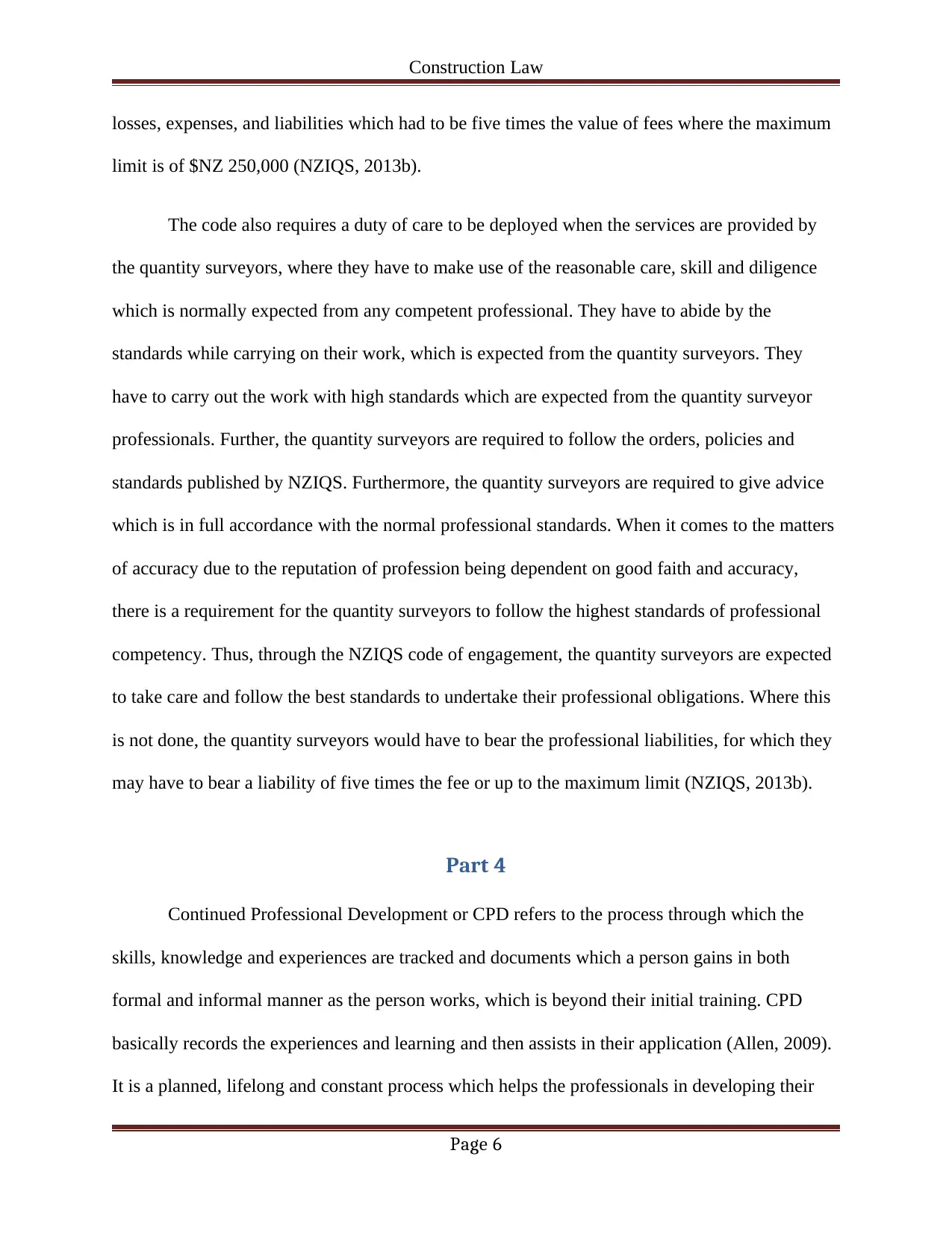
Construction Law
losses, expenses, and liabilities which had to be five times the value of fees where the maximum
limit is of $NZ 250,000 (NZIQS, 2013b).
The code also requires a duty of care to be deployed when the services are provided by
the quantity surveyors, where they have to make use of the reasonable care, skill and diligence
which is normally expected from any competent professional. They have to abide by the
standards while carrying on their work, which is expected from the quantity surveyors. They
have to carry out the work with high standards which are expected from the quantity surveyor
professionals. Further, the quantity surveyors are required to follow the orders, policies and
standards published by NZIQS. Furthermore, the quantity surveyors are required to give advice
which is in full accordance with the normal professional standards. When it comes to the matters
of accuracy due to the reputation of profession being dependent on good faith and accuracy,
there is a requirement for the quantity surveyors to follow the highest standards of professional
competency. Thus, through the NZIQS code of engagement, the quantity surveyors are expected
to take care and follow the best standards to undertake their professional obligations. Where this
is not done, the quantity surveyors would have to bear the professional liabilities, for which they
may have to bear a liability of five times the fee or up to the maximum limit (NZIQS, 2013b).
Part 4
Continued Professional Development or CPD refers to the process through which the
skills, knowledge and experiences are tracked and documents which a person gains in both
formal and informal manner as the person works, which is beyond their initial training. CPD
basically records the experiences and learning and then assists in their application (Allen, 2009).
It is a planned, lifelong and constant process which helps the professionals in developing their
Page 6
losses, expenses, and liabilities which had to be five times the value of fees where the maximum
limit is of $NZ 250,000 (NZIQS, 2013b).
The code also requires a duty of care to be deployed when the services are provided by
the quantity surveyors, where they have to make use of the reasonable care, skill and diligence
which is normally expected from any competent professional. They have to abide by the
standards while carrying on their work, which is expected from the quantity surveyors. They
have to carry out the work with high standards which are expected from the quantity surveyor
professionals. Further, the quantity surveyors are required to follow the orders, policies and
standards published by NZIQS. Furthermore, the quantity surveyors are required to give advice
which is in full accordance with the normal professional standards. When it comes to the matters
of accuracy due to the reputation of profession being dependent on good faith and accuracy,
there is a requirement for the quantity surveyors to follow the highest standards of professional
competency. Thus, through the NZIQS code of engagement, the quantity surveyors are expected
to take care and follow the best standards to undertake their professional obligations. Where this
is not done, the quantity surveyors would have to bear the professional liabilities, for which they
may have to bear a liability of five times the fee or up to the maximum limit (NZIQS, 2013b).
Part 4
Continued Professional Development or CPD refers to the process through which the
skills, knowledge and experiences are tracked and documents which a person gains in both
formal and informal manner as the person works, which is beyond their initial training. CPD
basically records the experiences and learning and then assists in their application (Allen, 2009).
It is a planned, lifelong and constant process which helps the professionals in developing their
Page 6
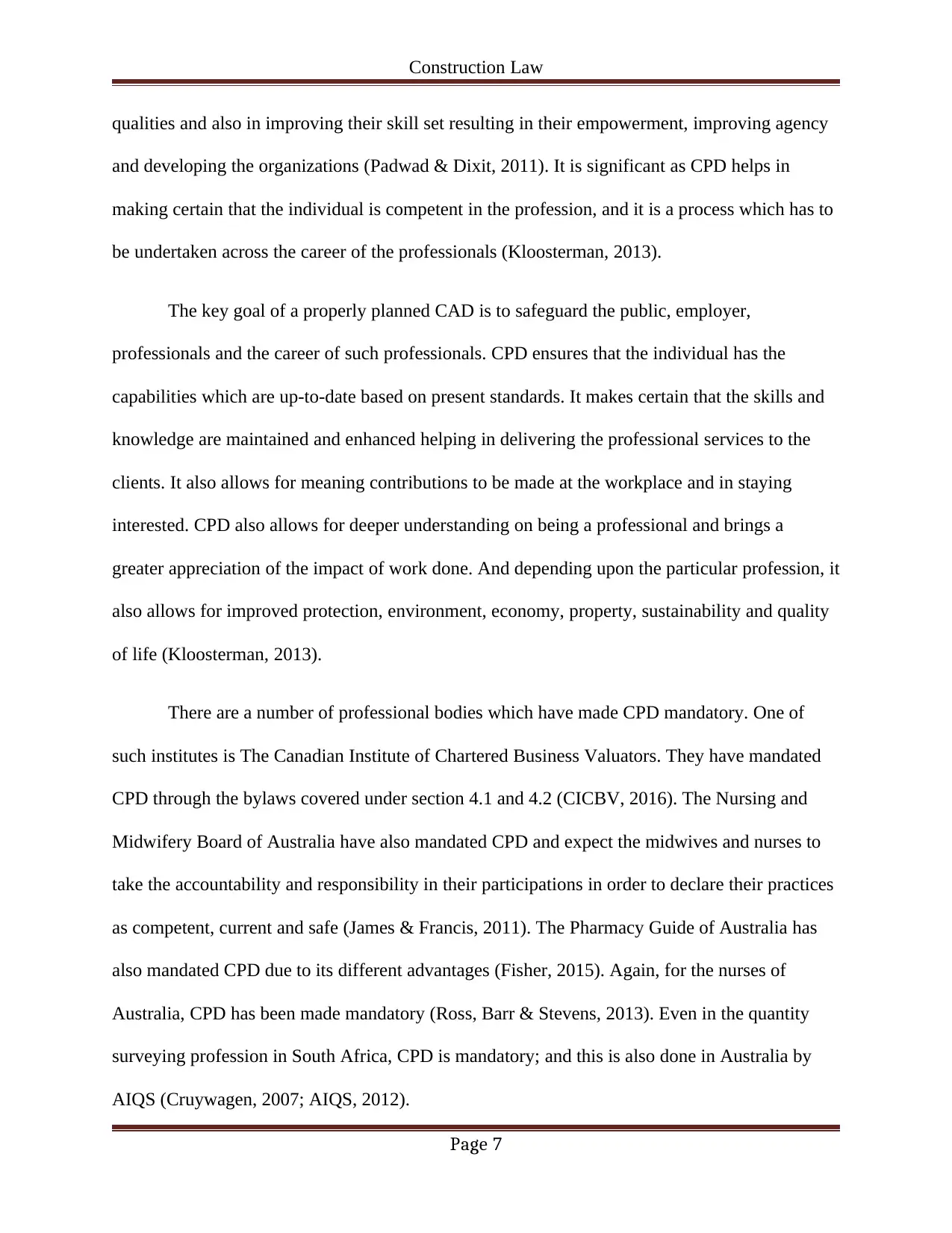
Construction Law
qualities and also in improving their skill set resulting in their empowerment, improving agency
and developing the organizations (Padwad & Dixit, 2011). It is significant as CPD helps in
making certain that the individual is competent in the profession, and it is a process which has to
be undertaken across the career of the professionals (Kloosterman, 2013).
The key goal of a properly planned CAD is to safeguard the public, employer,
professionals and the career of such professionals. CPD ensures that the individual has the
capabilities which are up-to-date based on present standards. It makes certain that the skills and
knowledge are maintained and enhanced helping in delivering the professional services to the
clients. It also allows for meaning contributions to be made at the workplace and in staying
interested. CPD also allows for deeper understanding on being a professional and brings a
greater appreciation of the impact of work done. And depending upon the particular profession, it
also allows for improved protection, environment, economy, property, sustainability and quality
of life (Kloosterman, 2013).
There are a number of professional bodies which have made CPD mandatory. One of
such institutes is The Canadian Institute of Chartered Business Valuators. They have mandated
CPD through the bylaws covered under section 4.1 and 4.2 (CICBV, 2016). The Nursing and
Midwifery Board of Australia have also mandated CPD and expect the midwives and nurses to
take the accountability and responsibility in their participations in order to declare their practices
as competent, current and safe (James & Francis, 2011). The Pharmacy Guide of Australia has
also mandated CPD due to its different advantages (Fisher, 2015). Again, for the nurses of
Australia, CPD has been made mandatory (Ross, Barr & Stevens, 2013). Even in the quantity
surveying profession in South Africa, CPD is mandatory; and this is also done in Australia by
AIQS (Cruywagen, 2007; AIQS, 2012).
Page 7
qualities and also in improving their skill set resulting in their empowerment, improving agency
and developing the organizations (Padwad & Dixit, 2011). It is significant as CPD helps in
making certain that the individual is competent in the profession, and it is a process which has to
be undertaken across the career of the professionals (Kloosterman, 2013).
The key goal of a properly planned CAD is to safeguard the public, employer,
professionals and the career of such professionals. CPD ensures that the individual has the
capabilities which are up-to-date based on present standards. It makes certain that the skills and
knowledge are maintained and enhanced helping in delivering the professional services to the
clients. It also allows for meaning contributions to be made at the workplace and in staying
interested. CPD also allows for deeper understanding on being a professional and brings a
greater appreciation of the impact of work done. And depending upon the particular profession, it
also allows for improved protection, environment, economy, property, sustainability and quality
of life (Kloosterman, 2013).
There are a number of professional bodies which have made CPD mandatory. One of
such institutes is The Canadian Institute of Chartered Business Valuators. They have mandated
CPD through the bylaws covered under section 4.1 and 4.2 (CICBV, 2016). The Nursing and
Midwifery Board of Australia have also mandated CPD and expect the midwives and nurses to
take the accountability and responsibility in their participations in order to declare their practices
as competent, current and safe (James & Francis, 2011). The Pharmacy Guide of Australia has
also mandated CPD due to its different advantages (Fisher, 2015). Again, for the nurses of
Australia, CPD has been made mandatory (Ross, Barr & Stevens, 2013). Even in the quantity
surveying profession in South Africa, CPD is mandatory; and this is also done in Australia by
AIQS (Cruywagen, 2007; AIQS, 2012).
Page 7
Paraphrase This Document
Need a fresh take? Get an instant paraphrase of this document with our AI Paraphraser
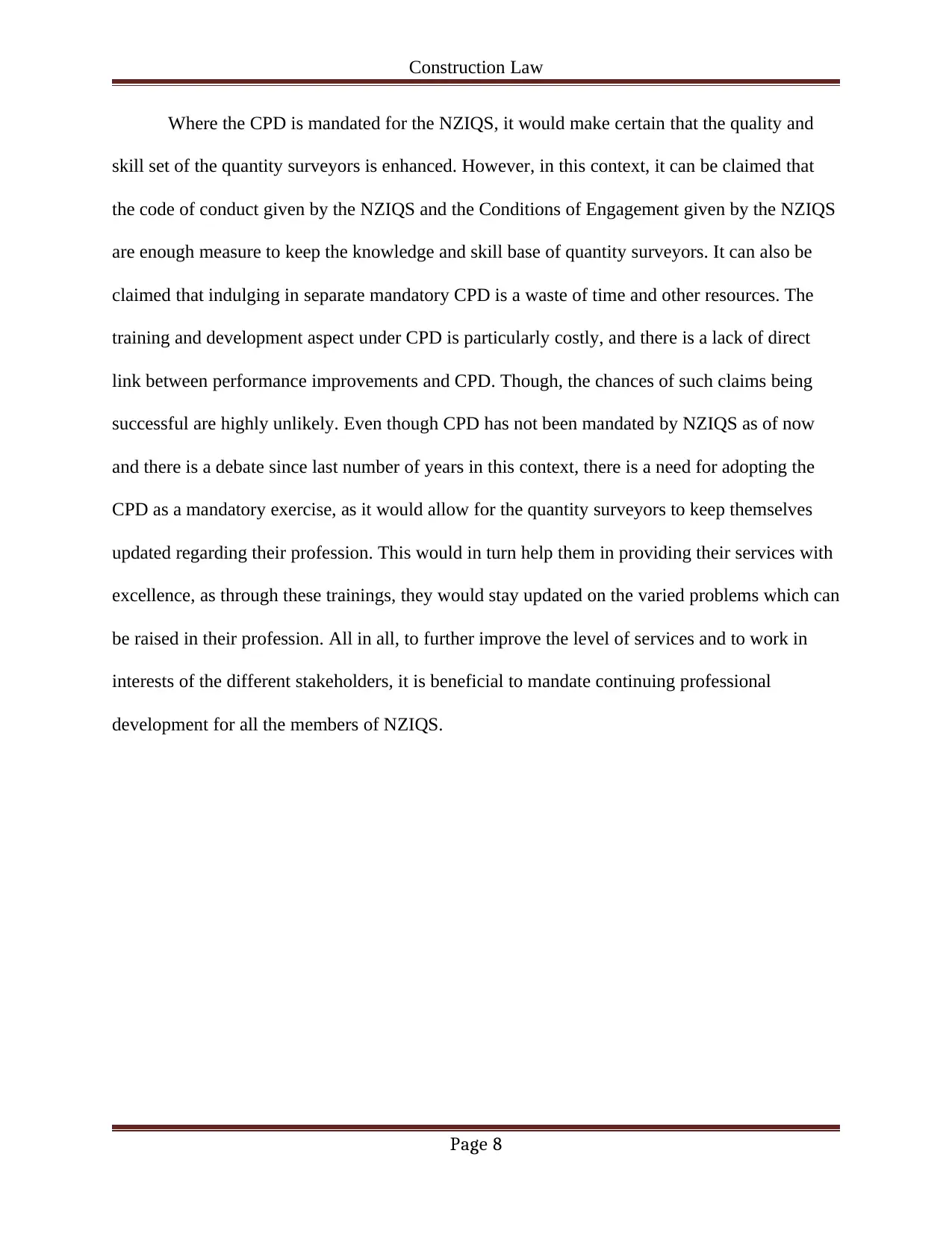
Construction Law
Where the CPD is mandated for the NZIQS, it would make certain that the quality and
skill set of the quantity surveyors is enhanced. However, in this context, it can be claimed that
the code of conduct given by the NZIQS and the Conditions of Engagement given by the NZIQS
are enough measure to keep the knowledge and skill base of quantity surveyors. It can also be
claimed that indulging in separate mandatory CPD is a waste of time and other resources. The
training and development aspect under CPD is particularly costly, and there is a lack of direct
link between performance improvements and CPD. Though, the chances of such claims being
successful are highly unlikely. Even though CPD has not been mandated by NZIQS as of now
and there is a debate since last number of years in this context, there is a need for adopting the
CPD as a mandatory exercise, as it would allow for the quantity surveyors to keep themselves
updated regarding their profession. This would in turn help them in providing their services with
excellence, as through these trainings, they would stay updated on the varied problems which can
be raised in their profession. All in all, to further improve the level of services and to work in
interests of the different stakeholders, it is beneficial to mandate continuing professional
development for all the members of NZIQS.
Page 8
Where the CPD is mandated for the NZIQS, it would make certain that the quality and
skill set of the quantity surveyors is enhanced. However, in this context, it can be claimed that
the code of conduct given by the NZIQS and the Conditions of Engagement given by the NZIQS
are enough measure to keep the knowledge and skill base of quantity surveyors. It can also be
claimed that indulging in separate mandatory CPD is a waste of time and other resources. The
training and development aspect under CPD is particularly costly, and there is a lack of direct
link between performance improvements and CPD. Though, the chances of such claims being
successful are highly unlikely. Even though CPD has not been mandated by NZIQS as of now
and there is a debate since last number of years in this context, there is a need for adopting the
CPD as a mandatory exercise, as it would allow for the quantity surveyors to keep themselves
updated regarding their profession. This would in turn help them in providing their services with
excellence, as through these trainings, they would stay updated on the varied problems which can
be raised in their profession. All in all, to further improve the level of services and to work in
interests of the different stakeholders, it is beneficial to mandate continuing professional
development for all the members of NZIQS.
Page 8
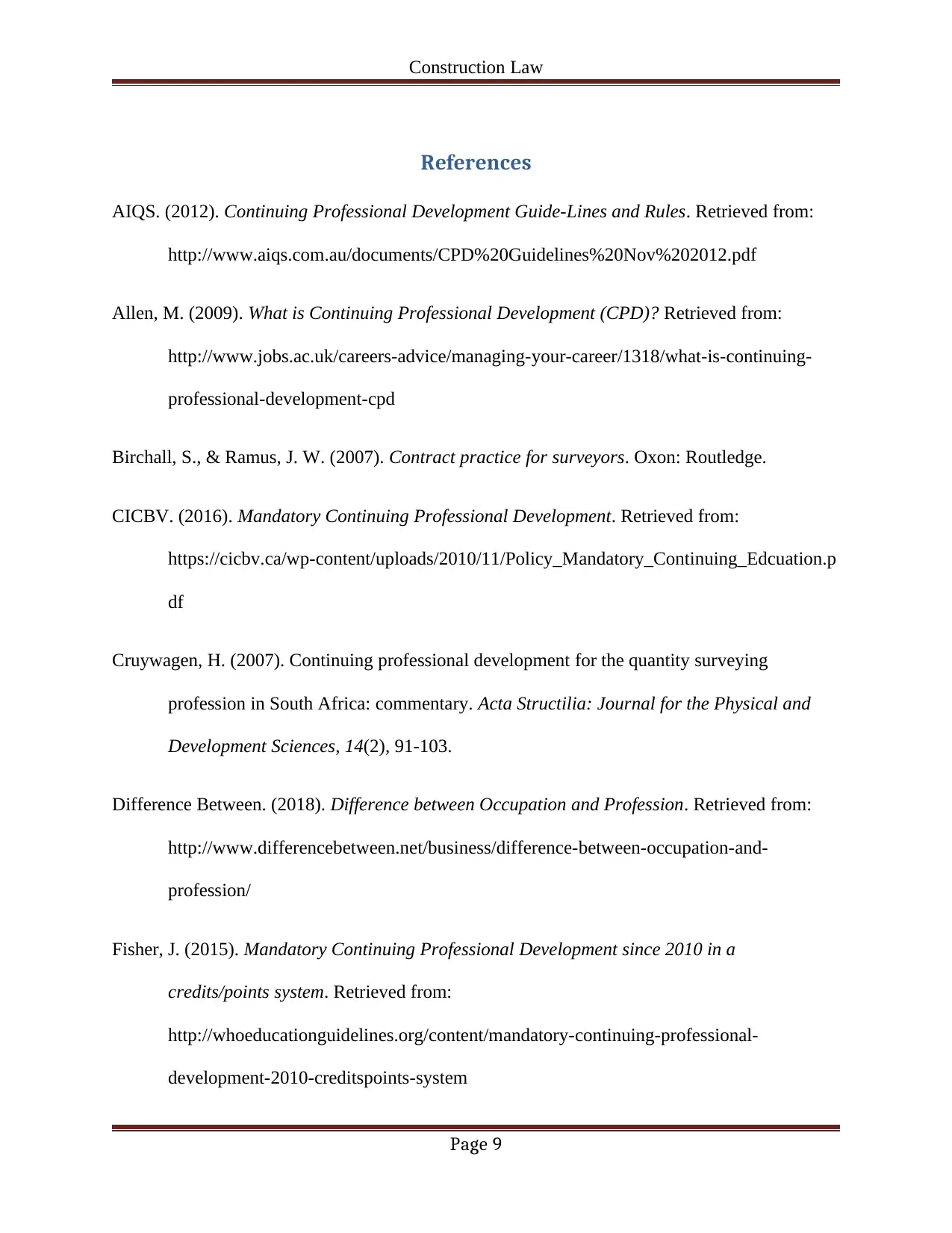
Construction Law
References
AIQS. (2012). Continuing Professional Development Guide-Lines and Rules. Retrieved from:
http://www.aiqs.com.au/documents/CPD%20Guidelines%20Nov%202012.pdf
Allen, M. (2009). What is Continuing Professional Development (CPD)? Retrieved from:
http://www.jobs.ac.uk/careers-advice/managing-your-career/1318/what-is-continuing-
professional-development-cpd
Birchall, S., & Ramus, J. W. (2007). Contract practice for surveyors. Oxon: Routledge.
CICBV. (2016). Mandatory Continuing Professional Development. Retrieved from:
https://cicbv.ca/wp-content/uploads/2010/11/Policy_Mandatory_Continuing_Edcuation.p
df
Cruywagen, H. (2007). Continuing professional development for the quantity surveying
profession in South Africa: commentary. Acta Structilia: Journal for the Physical and
Development Sciences, 14(2), 91-103.
Difference Between. (2018). Difference between Occupation and Profession. Retrieved from:
http://www.differencebetween.net/business/difference-between-occupation-and-
profession/
Fisher, J. (2015). Mandatory Continuing Professional Development since 2010 in a
credits/points system. Retrieved from:
http://whoeducationguidelines.org/content/mandatory-continuing-professional-
development-2010-creditspoints-system
Page 9
References
AIQS. (2012). Continuing Professional Development Guide-Lines and Rules. Retrieved from:
http://www.aiqs.com.au/documents/CPD%20Guidelines%20Nov%202012.pdf
Allen, M. (2009). What is Continuing Professional Development (CPD)? Retrieved from:
http://www.jobs.ac.uk/careers-advice/managing-your-career/1318/what-is-continuing-
professional-development-cpd
Birchall, S., & Ramus, J. W. (2007). Contract practice for surveyors. Oxon: Routledge.
CICBV. (2016). Mandatory Continuing Professional Development. Retrieved from:
https://cicbv.ca/wp-content/uploads/2010/11/Policy_Mandatory_Continuing_Edcuation.p
df
Cruywagen, H. (2007). Continuing professional development for the quantity surveying
profession in South Africa: commentary. Acta Structilia: Journal for the Physical and
Development Sciences, 14(2), 91-103.
Difference Between. (2018). Difference between Occupation and Profession. Retrieved from:
http://www.differencebetween.net/business/difference-between-occupation-and-
profession/
Fisher, J. (2015). Mandatory Continuing Professional Development since 2010 in a
credits/points system. Retrieved from:
http://whoeducationguidelines.org/content/mandatory-continuing-professional-
development-2010-creditspoints-system
Page 9
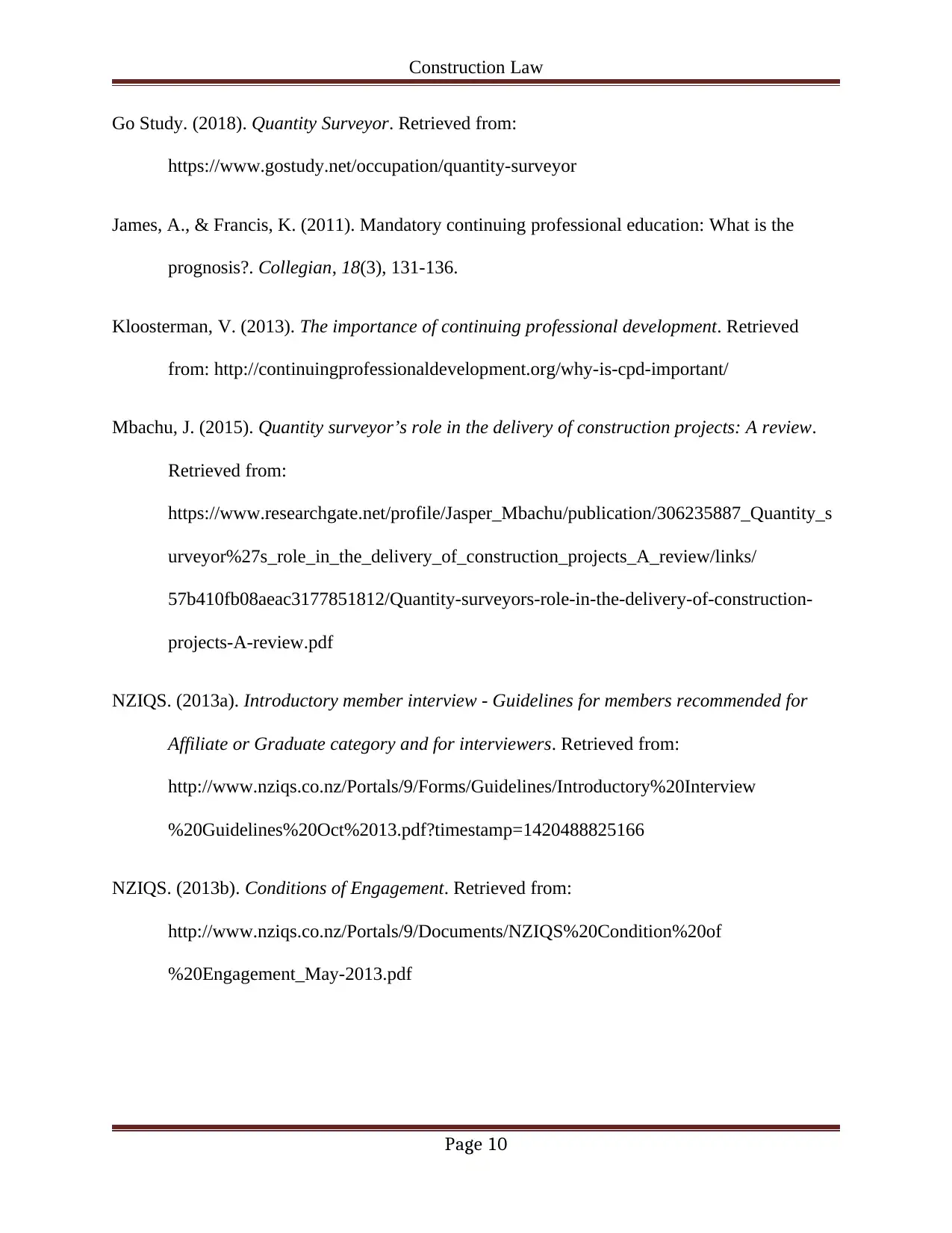
Construction Law
Go Study. (2018). Quantity Surveyor. Retrieved from:
https://www.gostudy.net/occupation/quantity-surveyor
James, A., & Francis, K. (2011). Mandatory continuing professional education: What is the
prognosis?. Collegian, 18(3), 131-136.
Kloosterman, V. (2013). The importance of continuing professional development. Retrieved
from: http://continuingprofessionaldevelopment.org/why-is-cpd-important/
Mbachu, J. (2015). Quantity surveyor’s role in the delivery of construction projects: A review.
Retrieved from:
https://www.researchgate.net/profile/Jasper_Mbachu/publication/306235887_Quantity_s
urveyor%27s_role_in_the_delivery_of_construction_projects_A_review/links/
57b410fb08aeac3177851812/Quantity-surveyors-role-in-the-delivery-of-construction-
projects-A-review.pdf
NZIQS. (2013a). Introductory member interview - Guidelines for members recommended for
Affiliate or Graduate category and for interviewers. Retrieved from:
http://www.nziqs.co.nz/Portals/9/Forms/Guidelines/Introductory%20Interview
%20Guidelines%20Oct%2013.pdf?timestamp=1420488825166
NZIQS. (2013b). Conditions of Engagement. Retrieved from:
http://www.nziqs.co.nz/Portals/9/Documents/NZIQS%20Condition%20of
%20Engagement_May-2013.pdf
Page 10
Go Study. (2018). Quantity Surveyor. Retrieved from:
https://www.gostudy.net/occupation/quantity-surveyor
James, A., & Francis, K. (2011). Mandatory continuing professional education: What is the
prognosis?. Collegian, 18(3), 131-136.
Kloosterman, V. (2013). The importance of continuing professional development. Retrieved
from: http://continuingprofessionaldevelopment.org/why-is-cpd-important/
Mbachu, J. (2015). Quantity surveyor’s role in the delivery of construction projects: A review.
Retrieved from:
https://www.researchgate.net/profile/Jasper_Mbachu/publication/306235887_Quantity_s
urveyor%27s_role_in_the_delivery_of_construction_projects_A_review/links/
57b410fb08aeac3177851812/Quantity-surveyors-role-in-the-delivery-of-construction-
projects-A-review.pdf
NZIQS. (2013a). Introductory member interview - Guidelines for members recommended for
Affiliate or Graduate category and for interviewers. Retrieved from:
http://www.nziqs.co.nz/Portals/9/Forms/Guidelines/Introductory%20Interview
%20Guidelines%20Oct%2013.pdf?timestamp=1420488825166
NZIQS. (2013b). Conditions of Engagement. Retrieved from:
http://www.nziqs.co.nz/Portals/9/Documents/NZIQS%20Condition%20of
%20Engagement_May-2013.pdf
Page 10
Secure Best Marks with AI Grader
Need help grading? Try our AI Grader for instant feedback on your assignments.
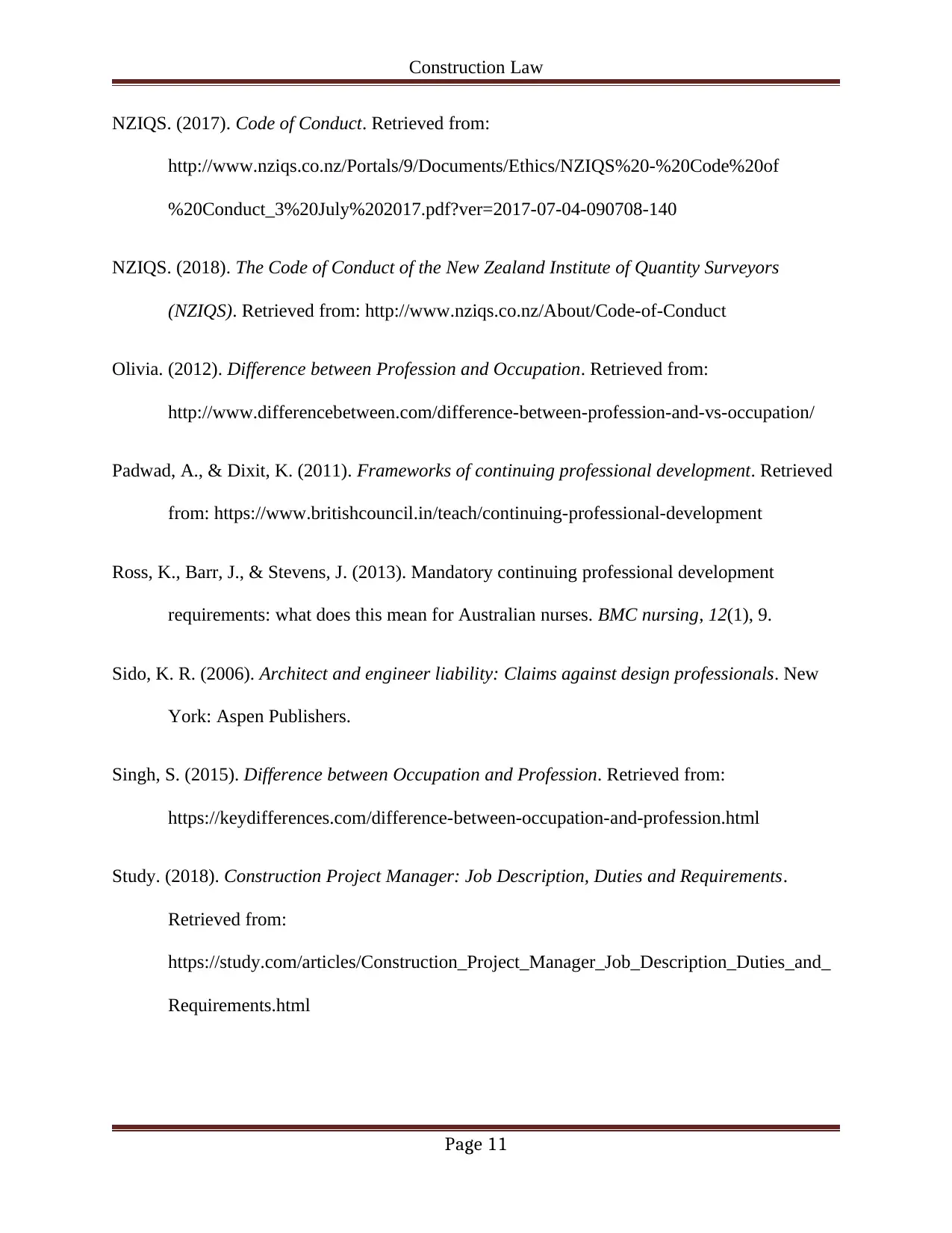
Construction Law
NZIQS. (2017). Code of Conduct. Retrieved from:
http://www.nziqs.co.nz/Portals/9/Documents/Ethics/NZIQS%20-%20Code%20of
%20Conduct_3%20July%202017.pdf?ver=2017-07-04-090708-140
NZIQS. (2018). The Code of Conduct of the New Zealand Institute of Quantity Surveyors
(NZIQS). Retrieved from: http://www.nziqs.co.nz/About/Code-of-Conduct
Olivia. (2012). Difference between Profession and Occupation. Retrieved from:
http://www.differencebetween.com/difference-between-profession-and-vs-occupation/
Padwad, A., & Dixit, K. (2011). Frameworks of continuing professional development. Retrieved
from: https://www.britishcouncil.in/teach/continuing-professional-development
Ross, K., Barr, J., & Stevens, J. (2013). Mandatory continuing professional development
requirements: what does this mean for Australian nurses. BMC nursing, 12(1), 9.
Sido, K. R. (2006). Architect and engineer liability: Claims against design professionals. New
York: Aspen Publishers.
Singh, S. (2015). Difference between Occupation and Profession. Retrieved from:
https://keydifferences.com/difference-between-occupation-and-profession.html
Study. (2018). Construction Project Manager: Job Description, Duties and Requirements.
Retrieved from:
https://study.com/articles/Construction_Project_Manager_Job_Description_Duties_and_
Requirements.html
Page 11
NZIQS. (2017). Code of Conduct. Retrieved from:
http://www.nziqs.co.nz/Portals/9/Documents/Ethics/NZIQS%20-%20Code%20of
%20Conduct_3%20July%202017.pdf?ver=2017-07-04-090708-140
NZIQS. (2018). The Code of Conduct of the New Zealand Institute of Quantity Surveyors
(NZIQS). Retrieved from: http://www.nziqs.co.nz/About/Code-of-Conduct
Olivia. (2012). Difference between Profession and Occupation. Retrieved from:
http://www.differencebetween.com/difference-between-profession-and-vs-occupation/
Padwad, A., & Dixit, K. (2011). Frameworks of continuing professional development. Retrieved
from: https://www.britishcouncil.in/teach/continuing-professional-development
Ross, K., Barr, J., & Stevens, J. (2013). Mandatory continuing professional development
requirements: what does this mean for Australian nurses. BMC nursing, 12(1), 9.
Sido, K. R. (2006). Architect and engineer liability: Claims against design professionals. New
York: Aspen Publishers.
Singh, S. (2015). Difference between Occupation and Profession. Retrieved from:
https://keydifferences.com/difference-between-occupation-and-profession.html
Study. (2018). Construction Project Manager: Job Description, Duties and Requirements.
Retrieved from:
https://study.com/articles/Construction_Project_Manager_Job_Description_Duties_and_
Requirements.html
Page 11
1 out of 11
Your All-in-One AI-Powered Toolkit for Academic Success.
+13062052269
info@desklib.com
Available 24*7 on WhatsApp / Email
![[object Object]](/_next/static/media/star-bottom.7253800d.svg)
Unlock your academic potential
© 2024 | Zucol Services PVT LTD | All rights reserved.
